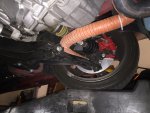CMbuildz Racing sent me a set of their aluminum brake ducts for test and evaluation. My next track day is 2/14, but I had a chance to install one side yesterday so thought I would post and add to it as information is gained.

Pull wheel, remove two 15 mm bolts from rear of hub, winkle the rotor/caliper assembly off hub. Note bungee cord holding rotor/caliper assembly to front spring above. Probably better ways to do this, but none faster.

Stock dust shield is held on with three 8 mm bolts. Easy.

Aluminum duct replacing stock. Same 3 8 mm bolts. Easy. Mirror image ducts make it impossible to install wrong one.

View from hub rear. 2" duct overlaps about 1/2" of inside rotor air vane opening, probably hard to see in pic but this is the best of my attempts to show.
Various measurements: hub 5" diameter and 3/8" thick. Rotor vane opening 5 3/4" diameter and fully exposed behind hub face (except for all the other parts inboard of rotor opening). CMB vent 2" OD, 1 13/16" ID.
I had all the parts on hand to neck down my 3" fog light facia ducts and install 2" hose to brake duct.

But when I pulled the fender liner aside, I realized my hard duct opening backside was angled wrong to accept connector stack, IC hose in the way, so have to pull front end off and revise rear side of duct to make connection. What I get for installing duct before having a hose size or route worked out.
My plan is to get the passenger side worked out and fully operational for testing on track, compare to stock drivers side using stock pads and rotors.

Pull wheel, remove two 15 mm bolts from rear of hub, winkle the rotor/caliper assembly off hub. Note bungee cord holding rotor/caliper assembly to front spring above. Probably better ways to do this, but none faster.

Stock dust shield is held on with three 8 mm bolts. Easy.

Aluminum duct replacing stock. Same 3 8 mm bolts. Easy. Mirror image ducts make it impossible to install wrong one.

View from hub rear. 2" duct overlaps about 1/2" of inside rotor air vane opening, probably hard to see in pic but this is the best of my attempts to show.
Various measurements: hub 5" diameter and 3/8" thick. Rotor vane opening 5 3/4" diameter and fully exposed behind hub face (except for all the other parts inboard of rotor opening). CMB vent 2" OD, 1 13/16" ID.
I had all the parts on hand to neck down my 3" fog light facia ducts and install 2" hose to brake duct.

But when I pulled the fender liner aside, I realized my hard duct opening backside was angled wrong to accept connector stack, IC hose in the way, so have to pull front end off and revise rear side of duct to make connection. What I get for installing duct before having a hose size or route worked out.
My plan is to get the passenger side worked out and fully operational for testing on track, compare to stock drivers side using stock pads and rotors.


![Popcorn [popcorn] [popcorn]](/images/smilies/popcorn.gif)















